
This killer whale has swam its last. Beached in the headwaters of the main feeder creek for our dam, it was crumpled among other abandoned PVC pool toys and left to deteriorate in the sun. Held by guest junk wranglers Richard and Marg.
Even though much of our block complies with the real estate agent’s descriptions of “very picturesque, rolling arable land”, running through the centre of the property are the badlands of eroded creeklines and junk heaps. With the thin veil of dry grass broken by the exposed earth of landslips, over time these fragile gullies have been repopulated with human detritus. While somewhat terrifying in its scale, the presence of so much rubbish also carries with it the strange appeal of a future satisfaction at having cleaned and restored the gullies to healthy, biodiverse waterways. As we work our way through gathering and disposing of the garbage, here we create an online home for some of the more unusual curios discovered among the shards of broken texta, rusted hulks of whitegoods and partially decomposed change-tables.
Item #1 Telecom Employee Identification Card
We began our clean-up in a pile of household rubbish adjacent to our preferred picnic spot. After clearing beneath mattresses that had rotted away to nothing more than a dusty mat of felt and a snarl of rusty springs, and sifting through good-as-new perma-pine posts and long-dry textas, we dug up this ID card. Perhaps the date (1986) gives a clue to the vintage of this particular junk pile. Indeed, the taste in partly-rotted textiles and abandoned shoes in this particular dump has a distinctly 80s vibe. The expiry date has a poignance: while the intended purpose of this particular object formally ended almost 30 years ago, its plastic capsule has ensured its persistence well into the next century.
Item #2 Souvenir Number Plate (Front and Rear View)
The presence of this item in the same junk heap as the Telecom ID is perhaps another indicator of era. It was found not far from the splintered, brittle remains of a souvenir road sign, traditionally seen some decades ago attached by suction cap to windows. It’s hard not to start drawing a narrative from the bits of junk found in this particular heap. Most are masculine, bent and brittle workboots, roadsigns, lumps of timber, with a handful of allusions to family life: a single platformed ladies’ shoe, a change table and a disposable nappy hungering for decomposition.
Item #3 Vehicle Identification Plate and Item #4 Vehicle Registration Plate RGJ-962
Near the top of one of the gullies on a bed of old tyres rests the body of a car. Its fittings and upholstered interior are gone, together with the engine and any other working parts. However, this ID plate and its registration plates were still nearby. The ID plate identified it as a Ford, and the distinctive curve of the panel over the front headlights, together with its zippy tail-fins and a chrome detail just behind the rear passenger windows suggested it to be the remains of a Ford Zephyr from the mid-1960s. The Registration Plate (Item #4), with the sequence RGJ-962, may support this rough time period, as the first alphanumeric number plate for South Australia was issued in 1966, with the sequence RAA-000.
Item #5 Vehicle Registration Plate VFB-547
This treasure was found in a midden that was otherwise dominated by the particular flavour of domestic waste we’ve become accustomed to (that is, shoes, truckers’ caps and plastic bags), with an empty Fruit Box found nearby dating its deposit to the early 2000s. Whether it belongs to a car body that we may yet discover beneath old sheets of corrugated iron elsewhere on the property remains to be seen.
Item #6 Rake head
As part of our property planning, we assembled a “Make, Borrow, Buy” list for tools and other items that we thought we might need access to in the first year of property development.. A rake came in not far down the list. While not exactly new, this rake head surfaced at just the right moment, and with some tender thumping has now been installed with a new handle. The junk heap provides.
Item #7 Door lock
This lock was found, together with three other similar locks buried beneath a Pick-up-sticks-style pile of concrete pylons. Their proximity to each other suggests that they were dumped as a collection, and continues to raise questions about the circumstances of the dumping. The array of items present almost seems to suggest that an entire house, complete with furniture and personal effects, was loaded onto a truck and tipped into the gully. As evidence of this, there are even loose kitchen drawers, still filled with cutlery.
Items #8-#10 Farm ephemera
Here we head into a selection of the numerous and generally mystifying general farm items. If you’re an old-time farming enthusiast, or a National Trust country museum devotee then let us know what contraptions you think they may have been part of.
Item #11 Golf balls
The tee-off for one of the more remote holes of a neighbouring resort’s golf course is separated from our property by a narrow strip of native revegetation. Clearly, the temptation to belt your ball as hard as you can into the surrounding farmland sometimes gets the better of even the most relaxed golfers.
Item #12 Vehicle Registration Plate TUR-252
Another day, another numberplate. This one was tenuously attached to the metal tail-gate of a car trailer. As far as we can tell, the trailer itself has ended up somewhere other than our creeks.
Item #13 Barbed Wire and Wooden Dispenser
A fine example of lo-fi engineering solutions, this entire assembly was partially buried in the headwaters of a creek. Evidently it had been there long enough for the timber and nails to deteriorate to the point of collapse. The galvanised wire, however, is intact and ready for use.
Item #14 Polystyrene Tray
Polystyrene remains one of the most contentious plastics due to its exceptionally long lived nature and its ubiquity making it a significant environmental hazard, particularly in aquatic environments. So here it is. The 6 sausages or 2 chops it hosted have long been digested, but this tray will resist degradation for centuries to come. It has perhaps been nibbled on by a passing creature, or battered in the water flow of the creek, but it remains rigid and resistant to breaking down in sun- or ultra-violet light.
Item #15 Blackout, by John J Nance
This delicate sculptural form is, unfortunately, not some rare and delicate fungus, but a well-loved copy of the novel Blackout, by John J Nance, a writer Publisher’s Weekly enthusiastically describes as “arguably the king of the modern-day aviation thriller”. Sometime ago, you could have delighted in the “non-stop action, never-say-die theatrics and stealth conspiracies” of this volume, and while Publisher’s Weekly warns that the “silly romance” between the two main characters should have been “jettisoned on takeoff”, Nance’s talent for “hair-raising in-flight emergency scenes” remains undiminished.
Item #16 Aluminum Venetian blind
Ever since we purchased this property we’ve been haunted by these Moebius-strip-esque ribbons of aluminium. I think we’ve almost got them all.
Item #17 Spent rifle cartridges and styrofoam holder
These cartridges, marked WIN REM 22-250 are the remains of very high-velocity rifle cartridges used in the US for “varmint and small game hunting”. In Australia, the Sporting Shooters Association recommends the .22-250 as an ideal cartridge for hunting foxes, feral cats and wild dogs, with other shooters also espousing its qualities in taking down feral goats, kangaroos and small deer.
Item #18 Diary
This diary, from 2003, was the record of a local farmer. While most pages are fused together with mould and moisture, a few sporadic entries remain. They are typically concise and mark agricultural achievements such as “All rams out”, “Finish boundary fence”, or “Wood shed”. The occasional Sunday is celebrated with “Fishing 14 whiting”.
Item #19 Wooden fishing floats
See above, “Fishing 14 whiting”.
Item #20 Sinutab tablets
Sinutab is a sinus decongestant and pain relief medication that incidentally contains pseudoephedrine, an ingredient that can be used in the illicit manufacture of methamphetamines. There were three tablets left, so I guess the previous owner started feeling better.
Item #21 The Rose cassette and case
The 1979 Bette Midler film The Rose is a musical drama loosely based on the life of Janis Joplin. While the film had modest success, the title track, once featured on this cassette, reached #3 on the US Billboard charts and garnered Midler a Grammy.
Item #27 Woodroofe’s bottle fragment
This chunk of glass is most likely the base of a bottle manufactured for Woodroofe’s lemonade. Founded in 1878, W. Woodroofe (aka. Woodies) was a South Australian producer of cordials and soft drinks, that remained a family business until the 1970s. It has since passed through a number of owners and is currently owned by Cadbury Schweppes. The bottle’s “Norwood SA” markings indicated the Woodroofe’s original Norwood bottling facility, while the striped triangle markings are part of the Woodroofe’s inverted tear-drop markings. It’s markings are similar to this Colonial era Woodroofe’s bottle, with slight variation in the typeface.
Item #28 Selection of beverage bottles
This selection of drink bottles, part of a rich vein of stubbies and other glassware in sections of the gullies, most likely hails from the early 1970s. The soft drink bottles from Schweppes, Shelley’s and Cottee’s company’s all carry imperial measurements so they predate the metrication of beverages that happened primarily by the end of 1974. Founded in Broken Hills in the 1890s, Shelley’s was an iconic New South Welsh soft drink brand, much like Hall’s in South Australia, although curiously, the bottles were produced in Edwardstown in the inner southern suburbs of Adelaide. It was bought out by British Tobacco (now Coca-Cola Amatil) in 1964, but continued trading under the Shelley’s brand until all of the regional soft drink labels (including Hall’s in SA) were rebranded nationally under the Kirk’s label by Coca Cola. The longneck and stubby in the foreground are examples of the iconic Pickaxe Brand of returnable beer bottles, produced in Thebarton until the mid-1990s, when interstate beer exports meant that it was no longer viable to use returnable, reusable bottles. The markings on the base, and the mention of Thebarton as the company location places these bottles after 1968, before which the bottles were labelled as being produced in Southwark. Pickaxe enthusiasts can read more here and here.
Item #30: Kodak Instamatic Camera 255x
The Kodak Instamatic Camera 255x went into production in 1971, and continued until 1977. It was distinguished from its predecessors by being equipped for Magicubes, or X-Flashcubes, a cube-shaped flash that could be fitted to the top. In the words of Camerapedia, the Magicubes looksed almost identical to their Flashcube predecessors, but instead of containing small, battery-powered globes, the flash was “fired mechanically by a small bar striking a pin coated in fulminating material. This simplified the system compared to flashcubes – by removing the need for a battery, and made extremely cheap flash cameras possible.”
Item #31: Mickey Mouse Plastic Mug
This Mickey Mouse plastic mug was produced as a promotion for Kentucky Fried Chicken in Australia in 1992, as part of a suite of Disney and Warner Brothers related mug tie-ins.

Item #37: Nicabate Committed Quitters Programme Cassette, with “Three Relaxation Methods You Can Try”

Item #47: Ceramic dinner plate shards
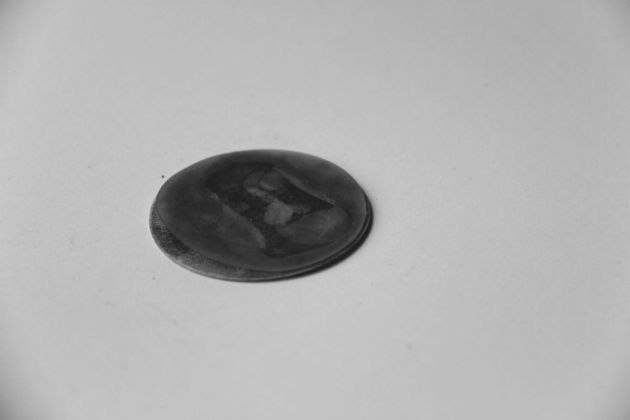
Item #48: 3D Limited Edition Tazo #71, depicting a ‘minion’ from the 1996 Michael Jordan/Looney Tunes film Space Jam. A mint-condition Tazo of this calibre has the current value of about $AUD0.75
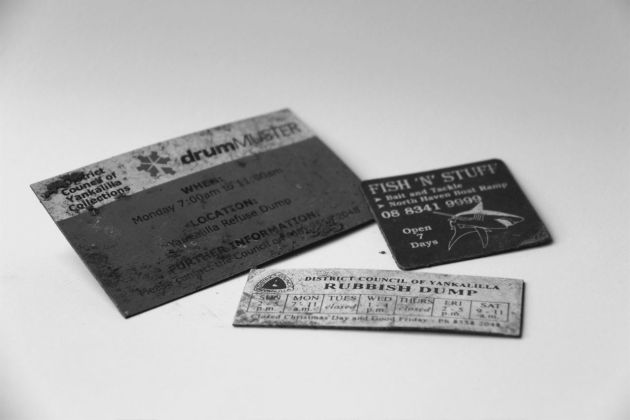
Item #49: assorted fridge magnets, including those relating to local waste disposal options, found still attached to a fridge dumped in the bottom of a gully. The irony is not lost on us.

Item #50: ‘Tummy Slimmer’ gel, distributed by Danoz Direct, as seen on TV












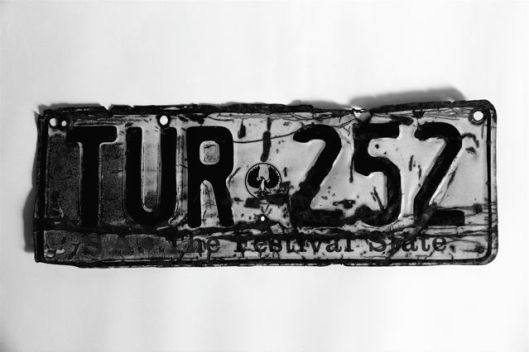




















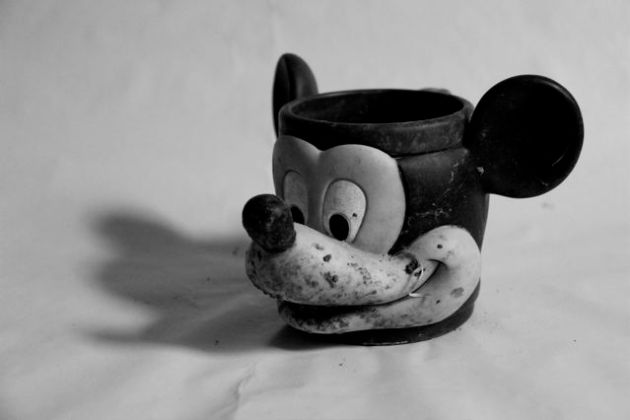

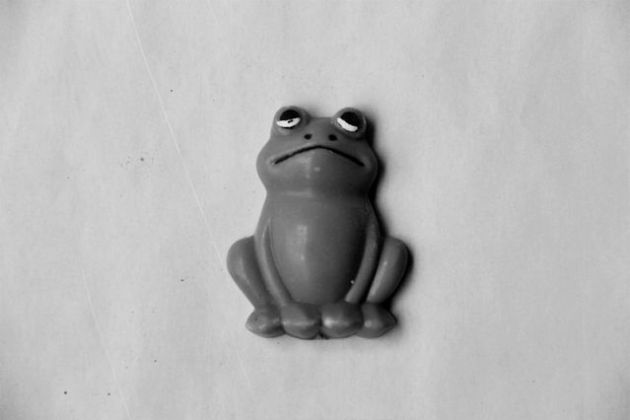
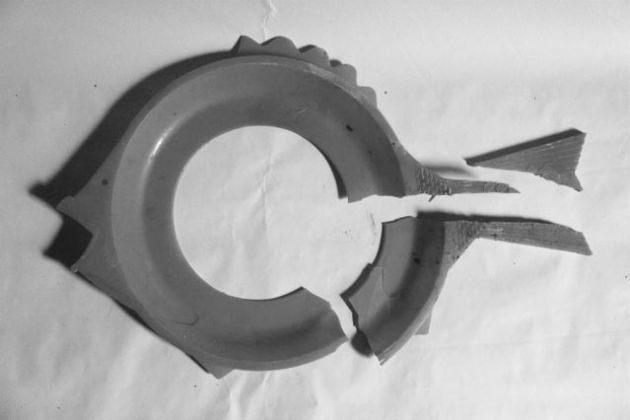











Oh my. What a collection! My efforts to clean up the neighbourhood are leading to some pretty extraordinary finds…. but not on this scale!
Thanks Mary, these are the archaeological highlights of I don’t know how many tonnes of other less photogenic white-goods, mattresses and demolition left-overs, and as hard as it is for us to believe I think we might almost be there! your care of your own neighbourhood is inspirational, but if you’re ever feeling especially forensic then you’re welcome to come and trawl our junk heaps too! You’re welcome to any treasures you discover!
Anthropocene gets thrown around a bit too frequently these days but seems like a good tag for talking about this non-ephemeral ephemera. Thank you for documenting these traces in such a thoughtful and amusing way.
Thanks Pippa, I agree! Certainly if the Anthropocene is a geological epoch, then places like our gullies suggest that in the distant future people might be able to age a landscape by the fragments of Duplo, broken cassettes and stiletto heels peppered through the sediment layers! As hot, dusty and mostly unpleasant cleaning a gully can be, the contemporary archaeological experience it offers can put one in quite a contemplative mood!
This is fantastic!